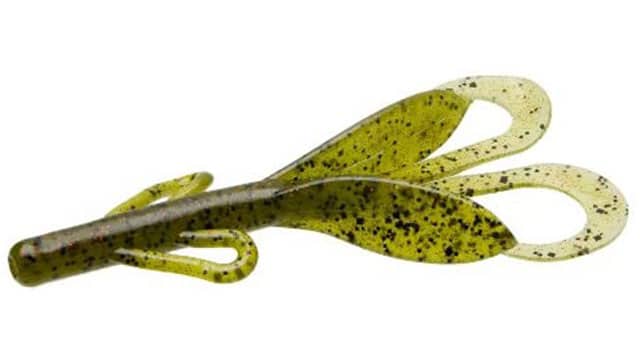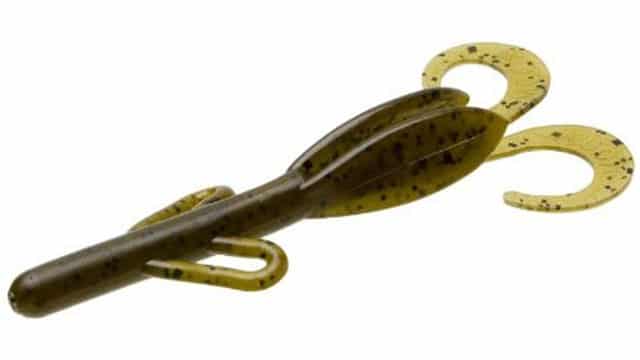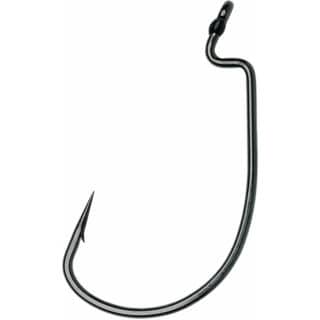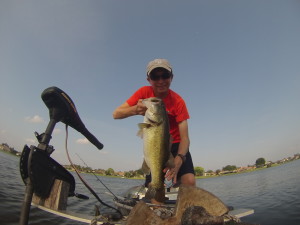You may have never heard of a brush hog. It is often an overlooked lure by many bass anglers. However, when utilized correctly, it can be one of the most effective soft-plastic baits out there.

Zoom Bait Brush Hog (Watermelon Red)

Zoom Bait Baby Brush Hog (Green Pumpkin)
What are Brush Hogs?
Brush hogs are a type of soft-plastic creature bait. They have a similar appearance to a soft-plastic lizard, however, have a much thicker body.
They have arms, legs, and a tail that give them a very lifelike appearance and erratic action in the water. They come in a variety of colors and sizes and are excellent lures for many situations when bass fishing.
Where to fish a brush hog
A soft-plastic brush hog is a reliable option when in many different situations when bass fishing. The bait excels when fished around any type of shallow shoreline cover and structure. It can be flipped into thick matted vegetation, crawled slowly along fallen timber, or worked along shoreline grass.
A brush hog works especially well during the spring because it imitates a lizard or some other type of intruder that is attempting to steal bass eggs. During this time of year, focusing on shallower cover is key.
The lure also works well when fished a little deeper off the bank around brush piles, rock piles, sand bars and shell beds. As spring turns to summer, focusing on these deeper water structures is often vital to catching more bass. Probing a brush hog around these areas can often score anglers large numbers of bass.
How to rig a brush hog
When it comes to rigging soft-plastic brush hogs, there are two methods that shine, including both Texas rigged and Carolina rigged.
It is best for anglers to Texas rig a brush hog when they are fishing shallow, shoreline cover and structure. Texas rigging the bait allows it to have a natural appearance as it falls into the strike zone.
Whether flipping heavy vegetation or brush, or simply fishing down a line of grass, this rigging your brush hog Texas style is the way to go.

When Texas rigging a brush hog, I prefer to use a 4/0 Trokar Flippin’ Hook. I vary the size of my weight depending on how thick the cover is that I will be fishing. If I’m flipping dense vegetation, I’ll use a 1-1½ ounce tungsten sinker. While, if I’m fishing thinner grass or laydown trees, I’ll go with a ¼-½ ounce tungsten sinker.
If anglers are fishing deeper water around offshore brush piles shell beds, sandbars, rockpiles and submerged grass, Carolina rigging a brush hog is often a better option. This technique allows the lure to remain off the bottom and flutter over the tops of cover and vegetation.

When Carolina rigging a brush hog, I like a 4/0 VMC EWG Hook. I typically go with a 3/8-½ ounce sinker positioned 14-16 inches above my hook.
Best rod and reel for brush hog fishing
I typically prefer one of two different rod and reel setups when fishing a brush hog. If flipping thick cover, I like a 7’ 6” heavy action baitcasting rod paired to a reel with a 6:4:1 gear ratio. A strong rod and powerful reel with a lot of torque is crucial in getting those large fish out of heavy cover.
If fishing around less dense vegetation or structure, I prefer a medium heavy action 7’ baitcasting rod, paired to a little fast reel with a 7:1:1 gear ratio.
Best line and leader for brush hog fishing
As far as line selection goes, I typically always use braided line with fluorocarbon leader when fishing with a brush hog. I’ll alter the size of my line and leader depending on the type of cover I’m fishing.
When fishing heavy grass or timber, I’ll use 50-65 pound braided line and 20-25-pound leader. When fishing thinner cover, I’ll go down to 30-40 pound braid and 15-17 pound leader.
An overlooked lure
With all the different styles of creature baits on the market, a soft-plastic brush hog is often ignored by many fishermen. As a result, it is often a bait that fish don’t see as often.
This can be critical to catching fish that experience a lot of pressure on a consistent basis. When employed properly, a soft-plastic brush hog can often get more bites that other types of creature baits.
Be sure to give a soft-plastic brush hog a try the next time you’re bass fishing. You may be surprised at the results!

